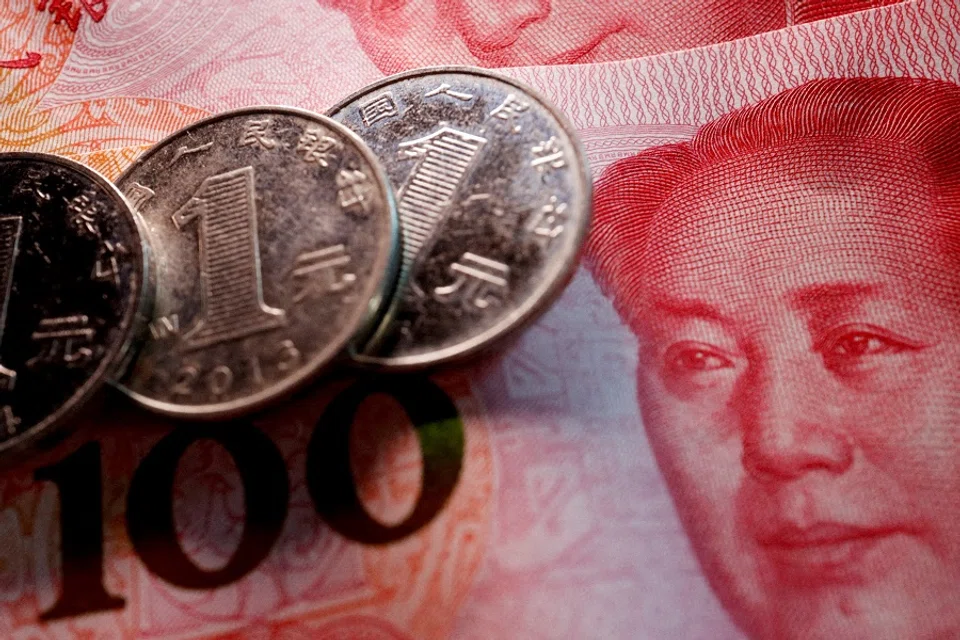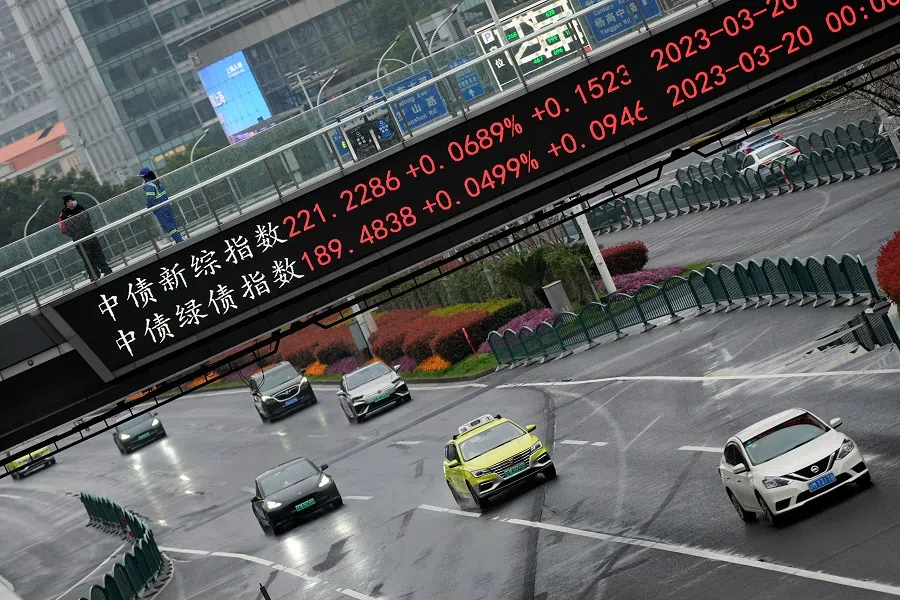China's capital flight: International investors' journey (back) to the West
Facing the threat of investment flight, China can seek to assuage fears with incentives, but in the long term, it would need to transform itself from a government-directed investment-driven economic growth model to a more balanced growth model from private sector investment and domestic consumption.

From early 2022 through the first half of 2023, around US$150 billion worth of Chinese bonds were sold by international institutional investors. These statistics are a U-turn following a 2022 upgrade in investment outlook by banks like Credit Suisse, UBS, Goldman Sachs, HSBC and Bernstein, and mark a sharp contrast to the post-Covid opening rally towards the end of 2022.
But as remnants of the Covid-19 pandemic gave way to a longer-term decrease in domestic consumer demand compared to expectations, market sentiment changed. Investors have sobered to other issues: the US-China trade war, the crackdown on the tech sector, the property market crisis, geopolitical tensions over Taiwan and the South China Sea, alignment over international alliances related to Eastern Europe and the Middle East, as well as policy disagreements relating to the development, distribution and use of advanced technology like artificial intelligence.
According to the State Administration of Foreign Exchange, China's net capital outflows reached US$75 billion in September 2023, the highest monthly level since January 2016, decreasing by almost 90% from a year ago.
Where is the capital flying to?
Several coinciding phenomena are amplifying the capital flight from China.
First, China's economy seems to be slowing down, with record-high leverage in the corporate and local government sectors. Retail sentiment has decreased, and the optimism from China's post-Covid opening up is fading. Second, with rising geopolitical risks such as concerns of outright war, global investors are worried their investments may lose value, their property rights may be violated, and their ownership over certain securities and assets may be deemed void. Third, the opportunity cost to invest in emerging markets has risen as the US Federal Reserve raises interest rates in America.

As China keeps rates low due to its weak economic fundamentals, international investors find it worthwhile to decrease their Chinese government bond holdings in favour of the higher rates paid by US Treasury bills.
Not all outflows need to go to the standard safe havens like the US, EU, Japan, Switzerland or Singapore. International investors who still have some risk-taking appetite may instead diversify away from China to other emerging markets such as Vietnam or India, which may have similar growth potential but less geopolitical risk.
When will capital flight end?
Consequently, the decreased demand for the RMB due to all three factors above has led to the renminbi weakening by more than 9% against the dollar since January 2023, reaching its lowest level since 2008. Although this seems like a negative outcome, we should remember that depreciation is a policy choice. If China were to maintain its exchange rate, it would need to raise interest rates domestically to entice foreign capital flows.
International investors will sell Chinese government bonds until the bonds' expected returns net of expected depreciation equals that of the US plus some risk premia. If the perceived risks of foreign investors holding Chinese government bonds are higher, then prices will need to decrease further until someone is willing to bear those risks.
... either the Chinese government must resolve some of the risks, or prices must fall sufficiently until the global market is willing to bear them.
As international investors process the deluge of information and re-evaluate risks about international economics and domestic policies, when will the capital flight end? When the risks themselves are alleviated, or securities appropriately reflect the prices of those risks. In other words, either the Chinese government must resolve some of the risks, or prices must fall sufficiently until the global market is willing to bear them. Such is the nature of risk premia in finance - no pain, no premium.

Given that the RMB has reached its lowest level in almost two decades, the expectation of future depreciations (partially due to the monetary divergence between China and the US), plus the concern about potential additional capital controls in the future, also compel international investors to pull their investments faster, reviving the phrase "China is uninvestable" emerging during the Covid lockdowns and 2022 big tech crackdowns.
International investors tend to shun not only the Chinese government debt but also the debt of other Chinese corporations. Given that Chinese companies have borrowed in the international corporate bond market in USD with short durations, typically one to two years, the capital flight and changes in investment preferences can introduce rollover risks to Chinese companies - even those that may not have the same underlying solvency problems like Country Garden or Evergrande. Starved of financing, those companies may be unable to maintain or expand operations.
What can be done?
One seemingly obvious solution to reduce capital outflow may be to restrict it directly. However, like water flowing through cracks in a dam, capital controls and regulatory oversight may be circumvented or evaded by various means and channels, such as using offshore entities and accounts, transferring funds through cryptocurrencies and digital platforms, or disguising capital outflows as trade or tourism payments. Not only do tightening capital controls punish compliers, but the concern of future tightening itself may cause international investors to flee.
However, these are counteracted by growing fears that other countries may also strategically stoke. For example, the US CIA director's statement of China preparing to invade Taiwan by 2027.
Another solution may be to try assuaging fears with incentives. To this end, China has tried to attract and retain foreign investment by offering more incentives and concessions, such as opening up more sectors and industries to foreign participation and reducing the barriers and restrictions on market access and ownership.
For example, on 26 May this year, the China Securities Regulatory Commission approved Morgan Stanley's proposal to establish a new wholly-owned subsidiary - the first in China (other international banks' presence is all in the form of joint ventures with a local partner). However, these are counteracted by growing fears that other countries may also strategically stoke. For example, the US CIA director's statement of China preparing to invade Taiwan by 2027.

Whether or not the Chinese government can calm global investors' fears remains to be seen. Previous direct interventions in the stock market are associated with positive effects. However, the direct interventions themselves do not resolve the underlying fundamentals and risks not only being a band-aid on a gushing wound but the cause of potential capital misallocation as well, as seen in Japan, which has also directly intervened in equity markets in the past.
Direct interventions in the foreign exchange market may be unsustainable, given the fundamental dislocations in monetary policy and economic conditions between China and the rest of the world. Even within Asia, data from LSEG Workspace shows out of 12 countries, China is the only one cutting interest rates.
China's challenge is to turn from a government-directed investment-driven economic growth model to a more balanced growth model from private sector investment and domestic consumption.
The more painful but sustainable solution would be to reduce the underlying policy risks. Implementing transparent regulations can instill confidence and address at least the policy-driven concerns behind the capital flight. The stability in regulatory frameworks can reassure foreign investors.
Nonetheless, the underlying geopolitical risk and debt issues remain. To that end, there must be mutual de-escalation in a coordinated effort with other global leaders and financial system reform to resolve existing misalignment of incentives due to the current financial condition and regulation. In the long term, China's challenge is to turn from a government-directed investment-driven economic growth model to a more balanced growth model from private sector investment and domestic consumption.




![[Big read] China’s 10 trillion RMB debt clean-up falls short](https://cassette.sphdigital.com.sg/image/thinkchina/d08cfc72b13782693c25f2fcbf886fa7673723efca260881e7086211b082e66c)
![[Big read] Love is hard to find for millions of rural Chinese men](https://cassette.sphdigital.com.sg/image/thinkchina/16fb62fbcf055b710e38d7679f82264ad682ce8b45542008afeb14d369a94399)